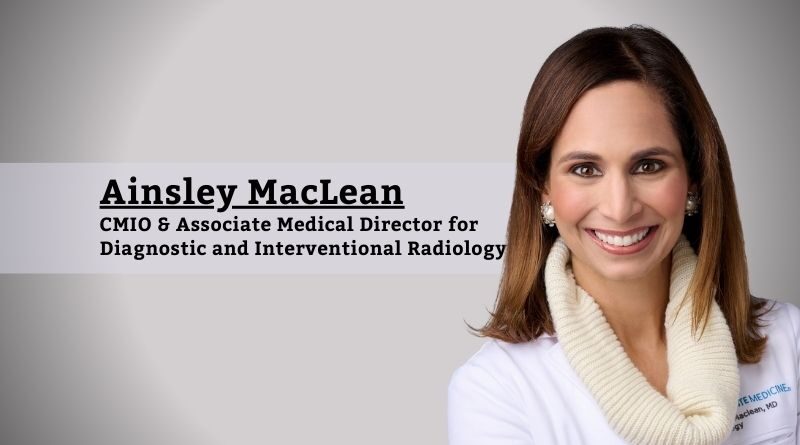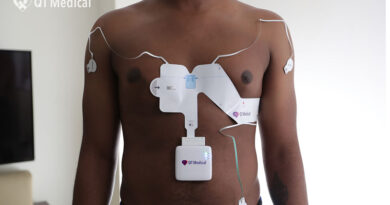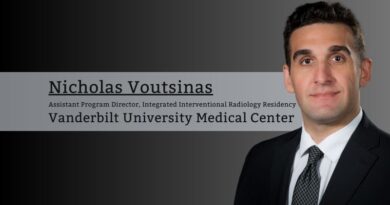Kaiser Permanente|Mid-Atlantic Permanente Medical Group
Healthcare Fueled by Technology
By Ainsley MacLean, MD, CMIO & Associate Medical Director for Diagnostic and Interventional Radiology, Kaiser Permanente|Mid-Atlantic Permanente Medical Group
TECHNOLOGY SCENARIO #1: INSTANT SCREENING MAMMOGRAM RESULTS
A woman undergoes a mammogram on a state-of-the-art 3D mammogram machine. The high-resolution images are transmitted via a network of high-speed cables where they are read on 5MP monitors by a highly trained radiologist physician covering clinical services across multiple states seamlessly in her home. The radiologist’s report is filed into a voice recognition software, PACS, the electronic medical record, while generating an MQSA required result letter, and both are released instantly to the patient via a HIPPA-compliant email system. The patient is in the parking lot when her smart phone “dings”. She opens the message letting her know that her mammogram shows no signs of breast cancer. She smiles with relief, thinking of her three children. Her number of ‘sleepless nights’ worrying about breast cancer is zero.
We know that screening mammograms save lives, however the non-urgency, substantial number of studies, regulations, and lower reimbursement rates place these at the “bottom of the stack” for many groups. The regulations require only that a woman receive her result within 30 days via “snail” mail. The typical wait time in the community is about 2 weeks.
At Kaiser Permanente Mid-Atlantic States, we believe our patients deserve better, and have focused on streamlining these results, from supporting CME, incentivizing internal value units, optimizing screening mammography worklists and dictation platforms, and the instantaneous release of reports, to create the superior experience our patients have come to expect. 97% of 450 women who are screened daily receive results within 30 minutes. For 10% who have abnormal mammograms, our breast tracking team reaches out same day to follow-up. If a breast biopsy is required, pathology results are available within 24 hours. If diagnosed with breast cancer, they are scheduled for a breast cancer clinic with a range of specialists.
These results pay off. We are a national leader in breast cancer screening, and our African American and Caucasian breast cancer patients having significantly lower mortality than the rest of the country. If everyone screened at the rates we do, 1200+ lives would be saved every year.
TECHNOLOGY SCENARIO #2: POINT OF CARE ULTRASOUND AND INTERVENTIONAL RADIOLOGY
At a hospital across town, a pregnant woman tells the nurse she is short of breath. The nurse calls out in the hallway for help. A cardiologist rushes into the room with his ultrasound probe attached to a smart tablet, places it over the heart, and using sound waves sees her right ventricle looks big. She has acute heart failure; he overhead pages the interventional radiologist on call. The radiologist subspecialist rushes her to the advanced imaging suite, and using state of the art biplane fluoroscopic technology, a tiny catheter and thrombectomy device, extracts clot from her pulmonary arteries, saving her life. She goes on to deliver a healthy baby girl.
Our physicians using POCUS have noted a fantastic patient experience. They are making the diagnosis quickly without waiting for a conventional ultrasound or echocardiogram, and that is shortening outpatient wait times and lengths of stay.
In most healthcare systems, there is no incentive for radiologists or cardiologists to support others in procurement of POCUS devices or help with physician training or quality. The incentives within the fee-for-service environment are aligned against it since the referring provider may no longer refer as often for ultrasound/echocardiogram. Within our collaborative salaried model at Kaiser Permanente Mid-Atlantic States, radiology and cardiology leadership oversee a large POCUS program of 14 specialty departments and support equipment and training in point-of-care ultrasound.
Our physicians using POCUS have noted a fantastic patient experience. They are making the diagnosis quickly without waiting for a conventional ultrasound or echocardiogram, and that is shortening outpatient wait times and lengths of stay. Our specialists have developed use-cases and training programs, to ensure quality is consistently exceptional. It has made their ability to diagnose and practice meaningful and rewarding.
TECHNOLOGY SCENARIO #3: ARTIFICIAL INTELLIGENCE IN RADIOLOGY DICTATION
Later that same evening, a diagnostic radiologist finishes his busy shift reading studies for patients across multiple states, however unlike all his prior shifts he does not feel tired. As he is dictating reports, artificial intelligence is generating the impression based on thousands of reads he has made previously. Technology is relieving him of cognitive burden while leveraging his knowledge and experience. This decreases fatigue, minimizing long-term burn-out and increasing professional satisfaction.
As a technology leader, the number of AI products on the market may seem overwhelming. While the adoption of many of these products remains relatively low in radiology, they have become more accurate and therefore this will likely change. AI companies are now listening to the consumers who have insight: the radiologists. Additionally, companies are doing a better job of sharing objective outcomes data, and finally recognizing that there needs to be a true return on investment. Someday a user-friendly radiology AI marketplace will be developed. Radiologists are at the table in many cases innovating, which leads to more useful products. Our first foray into commercial AI at Kaiser Permanente Mid-Atlantic States was not within imaging interpretation, but rather the dictation space. This proved to be transformative for our practice. A low footprint and low-profile product design has made the work of our radiologists less fatiguing, reports more concise, days more productive and therefore jobs more satisfying.
When we use digital technology to ensure the care we provide our patients is superior in both service and quality, this is a win for our physicians and patients. When we concurrently use AI to prevent physician burn out and nurture radiologists to read the millions of studies yet to come- this is truly the biggest win of all. Afterall, our patients deserve the best and will be requiring our care for decades to come.



